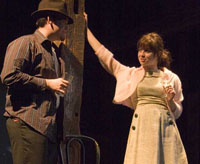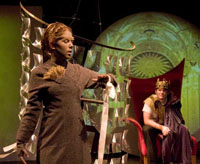The map will allow you to see the overall organization of the site/work, and pursue scenes or theory pieces in any order you choose. Alternatively, you can select the links at the bottom of each page to extend your investigation along a particular thread. Read on for a detailed description of the map or use the map now to enter the project, decoding its logic as you go The image map gives an overview of both the play and theory pages, allowing the interactor to proceed as s/he cares to, jumping from play to theory and back again, or reading the sequence of pages in a more linear way. The orange curve represents the original Andersen fable The Nightingale, reworked a bit for the stage. The purple curve corresponds to the contemporary revision—George and Marta’s story. The red and blue straight lines represent the theoretical discussions of the Andersen story and the George-Marta story, respectively. Where a straight line touches a curve, a point is marked with a black circle, each corresponding to a scene of the play (rolling over with your mouse will show a title for each page.) Similarly, rolling over the line segments shows the page titles for the theoretical sections. The horizontal axis of the map represents time, reflecting the play’s sequential unfolding in performance—its plot. The vertical line, on the other hand, is more abstract. At one end it refers to the diametric opposition between human and machine, at the other, to the notion of the post-human, a state in which the boundaries between humans and machines are porous, where the two coexist in a more blended state. Where the Andersen story remains absolutely horizontal, denoting no change in its dichotomous thinking about the relationship between the live and the machine, the George/Marta story climbs. This altitude gain suggests a departure from one of the central themes of the Andersen story—the binary opposition between the living and the machine. As George finds his bearings inside of technology, he is negotiating a very different kind of relationship with the machine, one defined by interdependence and collaboration. If I were a character in the play, I’d tell you to ignore everything you have read to this point. Instead know that the map you see above is simply a sound collage composed of the song of the Nightingale, the repetitive soundings of the Mechanical Nightingale, and one of Marta’s soundscapes. Here. Listen for yourself:
|
|||||||||


